Question
 Lola's spot
Lola's spot
Hi, I've been becoming more and more concerned about my betta fish, Lola. I bought her from Petsmart back in October (which I now know is not necessarily a good thing...) and she's grown a lot. Actually, I'm suspicious about whether or not she is a female because of how big her fins are. Anyway, about three or four months ago, she started developing a gray patch on her face. It was only one scale or so and she wasn't exhibiting any strange behavior. The spot seems to have grown a bit, but it's still only on her face. She's not acting strangely, she's eating like a little pig, still begs when she sees me in the room, hasn't lost weight, swims fine, isn't rubbing against anything, etc. It's just this gray patch and maybe some spinal curvature, but if that's present, it's not very pronounced and hasn't gotten any worse that I can see.
I change the water in the tank once a week (not more than 20% if conditions are normal). It's a ten gallon, fully-cycled tank which the betta shares with three cory catfish who show no symptoms of sickness at all. I have a heater and a whisper biowheel filter in there and I try to keep it at around 76. I treated the tank once with maracyn in case it was fin rot, but nothing seemed to happen. I'm worried about fish TB as I've read this is a death sentence for most fish.. I've attached the best picture of her that I could get.
Thank you,
Jess
AnswerHi Jess,
Spinal curvatures on bettas are not uncommon. Mass produced fish like zebra danios and neon tetras are prone to them too. It's usually the result of poor genes from these fish being overbred, but it could also be due to nutritional deficiencies as these fish were reared. Bettas have a rough life in the pet store. They are shipped in tiny bags with a few teaspoons of medicated water and then put into cups (which are, thankfully, about three times the size they used to be) with more medicated water. They are usually not fed very well at all at the store, and their water is often times not changed daily, the way it would need to be since they are in such a small amount of water.
Bettas don't need much to eat, but they are carnivores and as a result may not get enough stabilized Vitamin C. Using a high quality betta food, such as Hikari Bio-Gold, helps - but I would still go a step further and supplement the pellets or flakes you feed with some vitamins. They sell vitamins just for fish, but actually vitamins for birds, such as Vita Sol...
http://www.petsmart.com/product/index.jsp?productId=2754373
...Work almost as well and are much cheaper. When I am raising fry or nursing a sick fish back to health, I always put a drop of this vitamin in their food and let it soak for a bit. It does help!
So don't worry about Fish TB - there is lots written about it, especially since it can be transmitted to humans in the form of a skin infection, but in actuality it is uncommon.
What the grey patch COULD be, is fungus. Read about fungus here:
http://www.americanaquariumproducts.com/Columnaris.html
I especially wanted you to read this article because there are two kinds of fungus. One is Columnaris, caused by Flexibacter bacteria. This is a nasty disease but don't fret because it CAN be cured - you just need to use a serious medication like Triple Sulfa (don't bother with holistic meds if it is indeed Columnaris). Then there is Saprolegnia which is not really a true fungus, but it has the same kind of symptoms. This is not as aggressive and you can start with something like Pimafix. The best thing Pimafix has going for it is that you can use it right in your aquarium and you don't need to take the carbon out of the filter. With a medication like Triple Sulfa, you need to take the carbon out and you *should* treat the fish in a hospital tank, because the medication is very likely to harm your beneficial bacteria and cause your tank to have to "re-cycle" again somewhat.
So, this is what I would suggest you do. While your maintenance is great, I would go ahead and change a little more water weekly - about 30-40% or 3-4 gallons of water weekly. It won't hurt, it will only help! Extra clean water can make sick fish well all by itself, and it often times does.
Review the diet for your betta: are you offering enough variety? I keep 6 fish tanks, one of them is a 10 gallon betta tank with bettas and glowlight tetras. Since I have so many different fish, I feed my betta a little of what everyone else gets. Pellets (such as Hikari Micro Wafers and Micro Pellets) bits of algae wafers, shrimp pellets, flakes (meaty flakes like marine flake, brine shrimp flake, Tetramin, and also veggie and Spirulina) and frozen foods like bloodworms, Tubifex worms, and daphnia. I also feed my fish fresh veggies on a regular basis - a little bit of shredded cucumber, a cooked pea with the skin popped off, etc. I understand you probably can't get all these foods for your one 10 gallon tank, but do your best to offer variety. Omega One makes betta flakes that bettas really love. You can get some freeze dried bloodworms pretty cheaply - and the Hikari Micro Pellets/Wafers also come in small packages. And of course, Hikari Bio-Gold for bettas. Try to rotate the foods, and once a week just feed a shelled pea to your betta - probably 1/2 a pea twice a day. It will help prevent constipation (fiber) and give your betta a little vegetable matter.
Try the Pimafix first. It has a strong smell to it, but it's safe and gentle. With extra water changes, extra good food and Pimafix this may be enough to cure your betta. If the spot starts getting worse or starts looking red, raw or sunken you need to act fast and set up a hospital tank, and try a "real" medication that is effective against fungus. Hopefully, you won't need to!
I hope that helps, take care.
Nicole


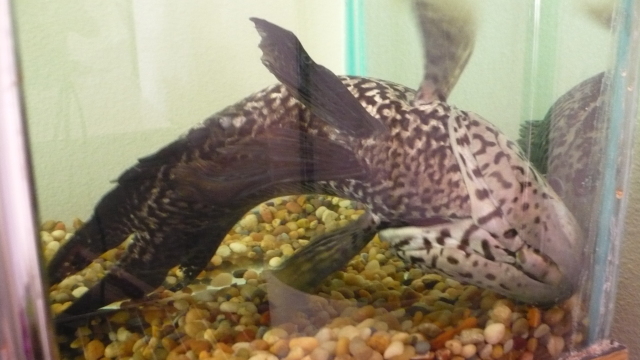 Swim Bladder Problem
Question
Buttnippers Problem
I have an 8 yr old Manguan
Swim Bladder Problem
Question
Buttnippers Problem
I have an 8 yr old Manguan
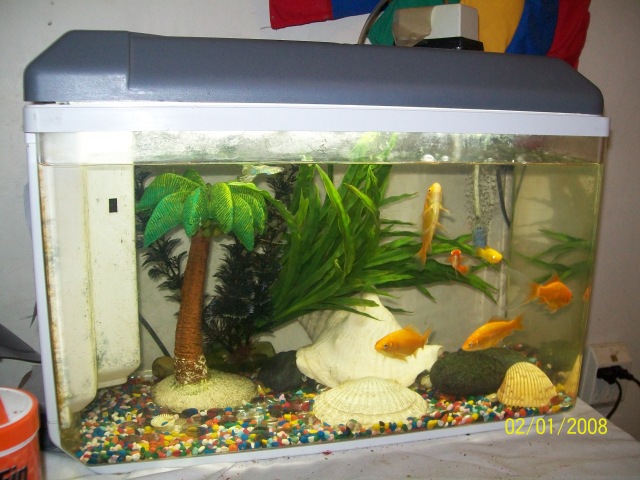 Whats a water hyacinth
Question
Whole tank
Renee, you answered my last questio
Whats a water hyacinth
Question
Whole tank
Renee, you answered my last questio
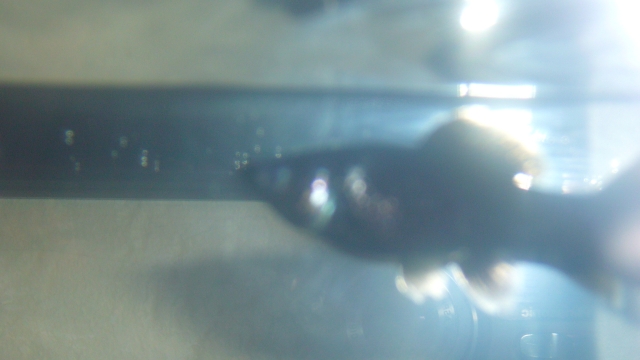 sick mollie
Question
sick mollie
I have a black mollie that is moth
sick mollie
Question
sick mollie
I have a black mollie that is moth
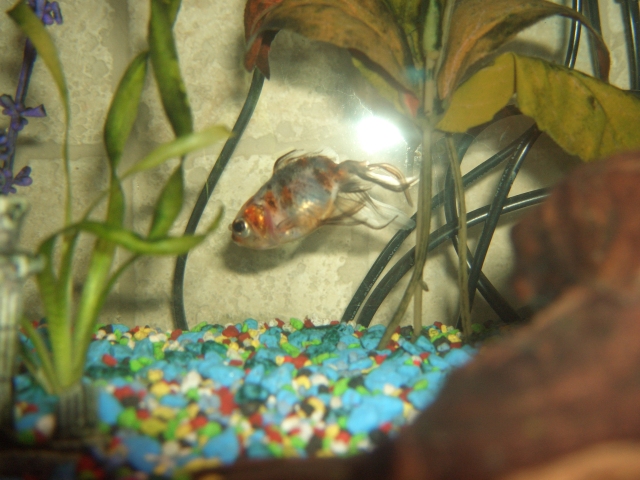 My sons Calico Orando - Bubbles!
QuestionBubbles
QUESTION: Weve had Bubbles for a
My sons Calico Orando - Bubbles!
QuestionBubbles
QUESTION: Weve had Bubbles for a
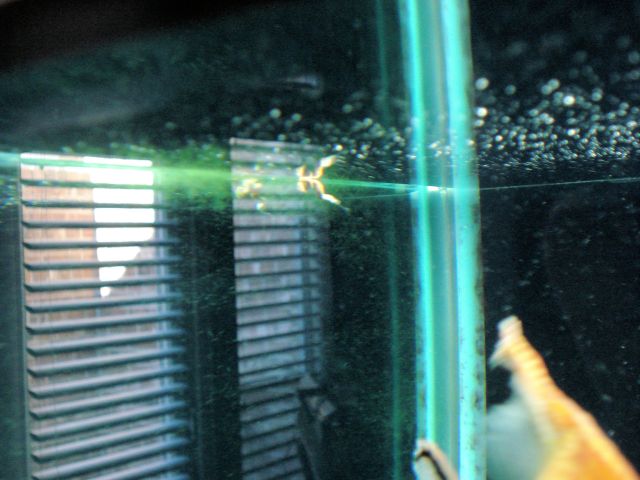 egg tube?
Question
Egg sack?
Occasionally, we have noticed
egg tube?
Question
Egg sack?
Occasionally, we have noticed